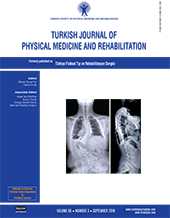Effects of cardiopulmonary rehabilitation on pulmonary arterial hypertension: A prospective, randomized study
2 Department of Chest Diseases, Division of Pulmonary, Ege Üniversitesi School of Medicine, Pulmonology, Izmir, Turkey
3 Department of Cardiology, Ege Üniversitesi School of Medicine, Izmir, Turkey DOI : 10.5606/tftrd.2019.2758 Objectives: This study aims to investigate the effects of cardiopulmonary rehabilitation (CPR) on cardiopulmonary function, quality of life, depression, and hemodynamic parameters in patients with pulmonary arterial hypertension (PAH) and to compare the efficacy of hospitaland home-based exercise programs.
Patients and methods: Between December 2014 to May 2016, a total of 30 patients with PAH were included in the study. The patients were randomly assigned to either a hospital-based (n=15) or home-based exercise program (n=15). The hospital group was assigned to a cardiac rehabilitation (three days/week, 1 hour/week 50 to 70% maximal oxygen uptake [PvO2]) program for eight weeks. The home-based exercise group received home exercises alone. Before and after eight weeks of rehabilitation, all patients were evaluated for their functional status (PvO2), pulmonary function including forced expiratory volume in one sec (FEV1), mL, forced vital capacity (FVC), mL and FEV1/FVC%, quality of life using Short Form-36 (SF-36), depression severity using Beck Depression Inventory, and hemodynamic parameters including left ventricular ejection fraction, right ventricular ejection fraction, left ventricular end-systolic diameter, left ventricular end-diastolic diameter, and systolic pulmonary arterial pressure.
Results: Of the patients, 12 completed the study in each group. There was no statistically significant difference in the functional status, quality of life, depression severity, and hemodynamic parameters after the rehabilitation compared baseline between the groups.
Conclusion: Based on our study results, short-term CPR seems not to be beneficial in patients with PAH. We recommend long-term rehabilitation programs to achieve more benefits from aerobic exercise training in this patient population.
Keywords : Aerobic exercise, cardiopulmonary rehabilitation, echocardiography, hemodynamics, pulmonary arterial hypertension, pulmonary functional tests, quality of life
















